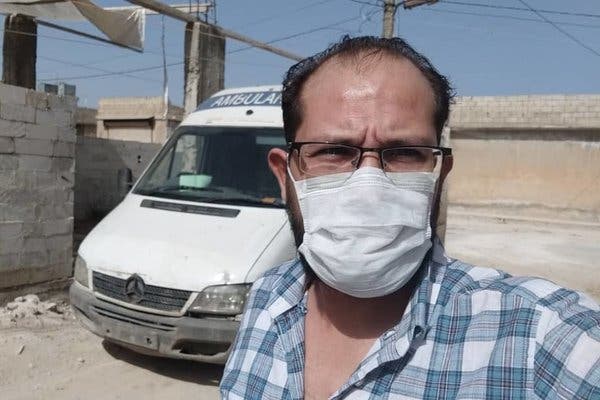An activist who has supported the democracy protests against Syria’s authoritarian president since they began nine years ago knows a thing or two about battling adversity. But Hosam al-Ali, 35, is more than a little worried about his new adversary: the coronavirus.
A pharmacist in Idlib, the last province still in the hands of Syrian opposition groups, Mr. al-Ali volunteered to be the main virus-response coordinator in his region.
An estimated 3.5 million people are crammed into the northern half of the province, at least half of them displaced, many in makeshift homes and tents. The lack of basic services, aid groups warn, makes Idlib particularly vulnerable to the virus.
As he set to work, Mr. al-Ali began keeping an audio diary, which he shared day by day with Carlotta Gall, the Istanbul bureau chief for The New York Times. His entries have been condensed, and edited for clarity.
April 1, 2020
The False Alarm
Today there was an announcement from the Minister of Health of the temporary government. We had concerns about 20 patients, and the results were negative. Thanks be to God.
April 3
A Day ‘Off’
It was a holiday, and a day off for me.
Like most Syrians who, on Friday, wake up and buy breakfast outside, I went to the center of Al-Atareb, which is very close to the front line and badly destroyed. There was only one breakfast shop open. It was very crowded and I had to wait.
I returned home to my wife and kids, and then I was fixing up solar panels and a battery. It was a very normal day.
Of course, I have coronavirus work, but I did this from home. There were a lot of communications, because I am on several WhatsApp chat groups.
The most important thing is training and social awareness, and how people should stay at home for safety. But society is disregarding that — that is the biggest problem we are facing.
Today they decided to cancel one of the new quarantine camps and make it a center for burning medical waste.
I have to prepare a lecture for midwife students at a university in Azaz on pharmacology. I have been teaching there for the last two years, but the whole university is going online because of the virus.
April 4
The Patient
We went to the Directorate of Health today and were trained on how to take a sample from a person suspected of being infected.
Then they brought us a patient.
He had a high temperature, and was ill with flulike symptoms. Of course, this patient had been one week under quarantine at home, not in a health center, and he came in for the test. The trainer carried it out.
April 5
A Day of Pain
Today I conducted training for the White Helmets [a Syrian civil defense group].
There were two teams, each with 10 people. We did two sessions to avoid crowding.
The next morning, I woke at 5 a.m., and we modified slides for the lecture. The slides outline the criteria for sending people to health facilities. They also tell people how to handle dead bodies.
The trainees from the White Helmets are very interested. Their motto, I learned, is from the Quran: “Whoever saves the life of one, it is as if he saves the life of all mankind.”
The whole day my mood was very bad, because my tooth infection had moved from my mouth to my eye, and it was very painful. I started to look like a teddy bear.
So I finished my training early and went to Ad Dana, a village 15 kilometers away from my house where a dentist treated the infection. I cried from the pain.
The dentist gave me some medicine, I went back home, ate a little bit and then went to sleep.
See you soon, or maybe not.
April 8
The White Helmets
Yesterday we trained 20 people. The day before, also. We reached 62 trainees in three days, all White Helmets. Afterward, we posted the training material to the WhatsApp group.
The White Helmets will be responsible for burying the bodies. This requires special procedures, and then the car needs to be sterilized after the burial. That is what I spoke about.
I also gave a lecture to students of the Institute for Midwives and the Institute of Pediatric Nurses. It was a good lecture, but a little bit harder than an in-person one. I could not understand the body language of the students. I tried shouting and repeating again and again.
Then I took my family out for 10 minutes outside. We drank coffee and the children drank juice and then we returned home.
God willing, Monday we will do another training session.
April 12
The Search for a Ventilator
Today I had a planning meeting on Zoom. Everyone had good ideas. Everyone would like to work. But in the end, the main problems are weakness of coordination and lack of financial means. It is because of that we are moving forward very, very slowly.
Yesterday a friend called me. He was looking for an incubator for his new born baby.
I found an incubator, but actually he needed a ventilator.
After we understood that we started looking for a ventilator, but unfortunately we could not find one. All the hospital ventilators were busy — and still we don’t have a single coronavirus case.
If that is happening, it means the medical capacity is very poor.
Today I felt depressed: I heard the baby died.
April 23
Before. And after.
Last week we trained a lot of teams on how to run a quarantine center. We found acceptance from a lot of organizations, and these organizations have some money which they could put toward this.
We divided the session into two parts: Before the virus appears in our area, and after.
In the first part it is about health awareness.
We will supply soap and clean water in the market and two tents for the center: one for isolation, and one for testing.
-
Frequently Asked Questions and Advice
Updated June 5, 2020
-
Does asymptomatic transmission of Covid-19 happen?
So far, the evidence seems to show it does. A widely cited paper published in April suggests that people are most infectious about two days before the onset of coronavirus symptoms and estimated that 44 percent of new infections were a result of transmission from people who were not yet showing symptoms. Recently, a top expert at the World Health Organization stated that transmission of the coronavirus by people who did not have symptoms was “very rare,” but she later walked back that statement.
-
How does blood type influence coronavirus?
A study by European scientists is the first to document a strong statistical link between genetic variations and Covid-19, the illness caused by the coronavirus. Having Type A blood was linked to a 50 percent increase in the likelihood that a patient would need to get oxygen or to go on a ventilator, according to the new study.
-
How many people have lost their jobs due to coronavirus in the U.S.?
The unemployment rate fell to 13.3 percent in May, the Labor Department said on June 5, an unexpected improvement in the nation’s job market as hiring rebounded faster than economists expected. Economists had forecast the unemployment rate to increase to as much as 20 percent, after it hit 14.7 percent in April, which was the highest since the government began keeping official statistics after World War II. But the unemployment rate dipped instead, with employers adding 2.5 million jobs, after more than 20 million jobs were lost in April.
-
Will protests set off a second viral wave of coronavirus?
Mass protests against police brutality that have brought thousands of people onto the streets in cities across America are raising the specter of new coronavirus outbreaks, prompting political leaders, physicians and public health experts to warn that the crowds could cause a surge in cases. While many political leaders affirmed the right of protesters to express themselves, they urged the demonstrators to wear face masks and maintain social distancing, both to protect themselves and to prevent further community spread of the virus. Some infectious disease experts were reassured by the fact that the protests were held outdoors, saying the open air settings could mitigate the risk of transmission.
-
How do we start exercising again without hurting ourselves after months of lockdown?
Exercise researchers and physicians have some blunt advice for those of us aiming to return to regular exercise now: Start slowly and then rev up your workouts, also slowly. American adults tended to be about 12 percent less active after the stay-at-home mandates began in March than they were in January. But there are steps you can take to ease your way back into regular exercise safely. First, “start at no more than 50 percent of the exercise you were doing before Covid,” says Dr. Monica Rho, the chief of musculoskeletal medicine at the Shirley Ryan AbilityLab in Chicago. Thread in some preparatory squats, too, she advises. “When you haven’t been exercising, you lose muscle mass.” Expect some muscle twinges after these preliminary, post-lockdown sessions, especially a day or two later. But sudden or increasing pain during exercise is a clarion call to stop and return home.
-
My state is reopening. Is it safe to go out?
States are reopening bit by bit. This means that more public spaces are available for use and more and more businesses are being allowed to open again. The federal government is largely leaving the decision up to states, and some state leaders are leaving the decision up to local authorities. Even if you aren’t being told to stay at home, it’s still a good idea to limit trips outside and your interaction with other people.
-
What’s the risk of catching coronavirus from a surface?
Touching contaminated objects and then infecting ourselves with the germs is not typically how the virus spreads. But it can happen. A number of studies of flu, rhinovirus, coronavirus and other microbes have shown that respiratory illnesses, including the new coronavirus, can spread by touching contaminated surfaces, particularly in places like day care centers, offices and hospitals. But a long chain of events has to happen for the disease to spread that way. The best way to protect yourself from coronavirus — whether it’s surface transmission or close human contact — is still social distancing, washing your hands, not touching your face and wearing masks.
-
What are the symptoms of coronavirus?
Common symptoms include fever, a dry cough, fatigue and difficulty breathing or shortness of breath. Some of these symptoms overlap with those of the flu, making detection difficult, but runny noses and stuffy sinuses are less common. The C.D.C. has also added chills, muscle pain, sore throat, headache and a new loss of the sense of taste or smell as symptoms to look out for. Most people fall ill five to seven days after exposure, but symptoms may appear in as few as two days or as many as 14 days.
-
How can I protect myself while flying?
If air travel is unavoidable, there are some steps you can take to protect yourself. Most important: Wash your hands often, and stop touching your face. If possible, choose a window seat. A study from Emory University found that during flu season, the safest place to sit on a plane is by a window, as people sitting in window seats had less contact with potentially sick people. Disinfect hard surfaces. When you get to your seat and your hands are clean, use disinfecting wipes to clean the hard surfaces at your seat like the head and arm rest, the seatbelt buckle, the remote, screen, seat back pocket and the tray table. If the seat is hard and nonporous or leather or pleather, you can wipe that down, too. (Using wipes on upholstered seats could lead to a wet seat and spreading of germs rather than killing them.)
-
How do I take my temperature?
Taking one’s temperature to look for signs of fever is not as easy as it sounds, as “normal” temperature numbers can vary, but generally, keep an eye out for a temperature of 100.5 degrees Fahrenheit or higher. If you don’t have a thermometer (they can be pricey these days), there are other ways to figure out if you have a fever, or are at risk of Covid-19 complications.
-
Should I wear a mask?
The C.D.C. has recommended that all Americans wear cloth masks if they go out in public. This is a shift in federal guidance reflecting new concerns that the coronavirus is being spread by infected people who have no symptoms. Until now, the C.D.C., like the W.H.O., has advised that ordinary people don’t need to wear masks unless they are sick and coughing. Part of the reason was to preserve medical-grade masks for health care workers who desperately need them at a time when they are in continuously short supply. Masks don’t replace hand washing and social distancing.
-
What should I do if I feel sick?
If you’ve been exposed to the coronavirus or think you have, and have a fever or symptoms like a cough or difficulty breathing, call a doctor. They should give you advice on whether you should be tested, how to get tested, and how to seek medical treatment without potentially infecting or exposing others.
-
How do I get tested?
If you’re sick and you think you’ve been exposed to the new coronavirus, the C.D.C. recommends that you call your healthcare provider and explain your symptoms and fears. They will decide if you need to be tested. Keep in mind that there’s a chance — because of a lack of testing kits or because you’re asymptomatic, for instance — you won’t be able to get tested.
-
We will raise awareness of the people not to bring their children to the clinic, and only to come in an emergency.
And we will spray-paint health messages on the town walls.
All that is before the virus appears.
After it is here, there will be more serious coordination with the White Helmets, the local council and civil society organizations.
The plan is to put tents at the entrance of Al-Atareb. People will pass through the tents and be registered. If we have any doubts about someone who is trying to come into Al-Atareb, we will take them to the quarantine center.
There will also be a kind of home isolation for everybody, and there is a team of women who volunteered to teach people how to make homemade masks.
The White Helmets will start using their vehicles to disinfect the public areas.
The situation of the health authority is very, very bad. The Health Directorate laid off some employees and gave others unpaid leave because of the financial situation.
The rest of the employees will be paid $100 a month.
You know: $100 is nothing. I will pay $50 for my rent and $50 for fuel for my car. How will I deal for the rest of the month?
Soon, Ramadan is coming and the market will be crowded.
But I think the sickness will not spread too much in our area if we apply the plan. Each village should do social management. We need to spread awareness to the people to do self-isolation and social distancing, and then we will be in good shape.
Happy Ramadan — and I hope this year will be good for all the world.
May 3
Tents and Thermometers
Greetings.
It is really hard with Ramadan. We have a lot of work and it makes me tired.
The Kafr Karmin quarantine center has begun its work. This center is receiving people who are coming from Turkey. The border authorities are taking them to the center and isolating them for 14 days.
I also have a bad situation at home. My wife started crying.
Our fridge is not working and every day I say I will get a new one or fix it and I did not do it. And some of the windows are broken and I did not fix them. I am really busy, and when I am busy I forget.
May 5
Pressure on all Fronts
There is something very important going on these days. It is not about coronavirus.
It is about the people.
They are in a very difficult situation. Everything is super-expensive now. The dollar is rising and the Syrian pound is on the floor. The rate of one dollar is 1,500 Syrian pounds.
People are going crazy. God help the people with Ramadan, coronavirus and high prices. God help the people.
*
Update: As of this week, Idlib has had no reported cases of infection.
Saad al-Nassife contributed reporting from Gaziantep, Turkey.



















